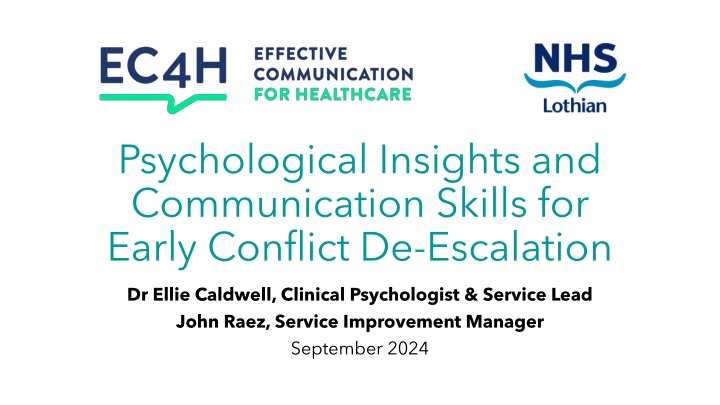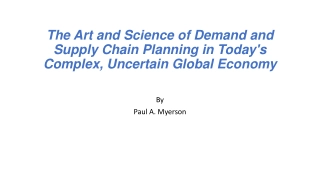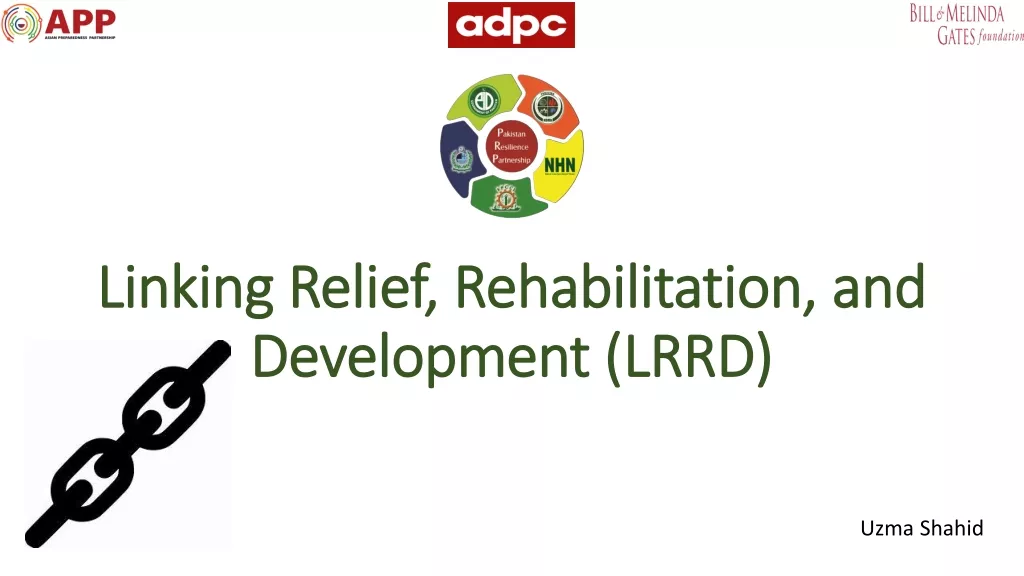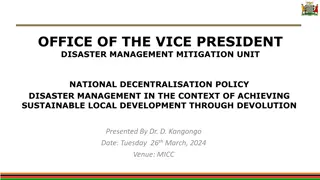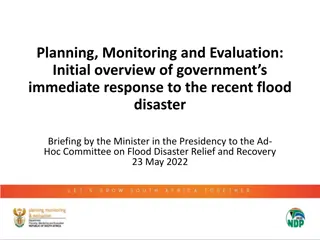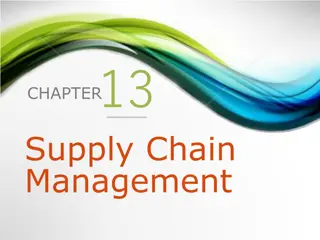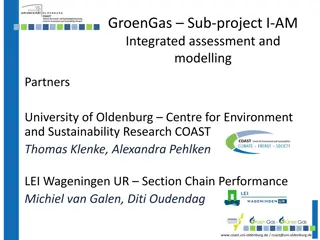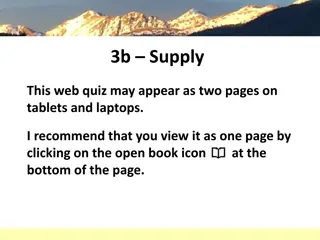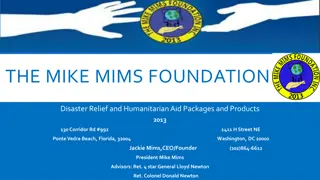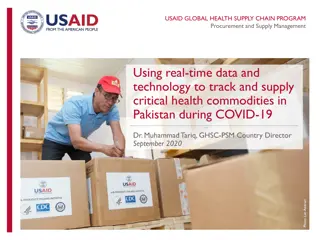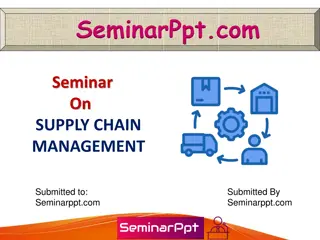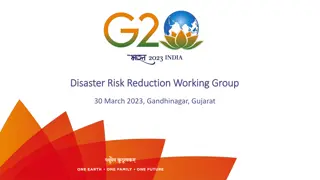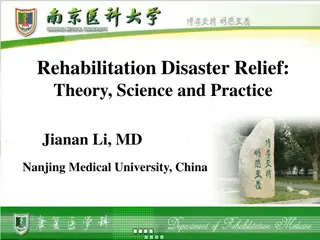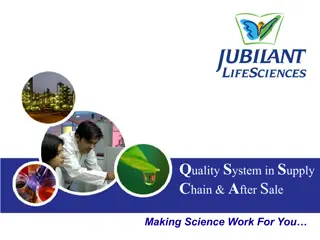Enabling Supply Chain Coordination in Disaster Relief
Simulation for evaluating a proposed systems architecture for enabling supply chain coordination in disaster relief. Information sharing is critical, and a prototype system is being developed for sharing between the end of supply chains. The approach involves using backlogs as a proxy for deprivation costs and vertical information sharing between retailers across supply chains.
Download Presentation

Please find below an Image/Link to download the presentation.
The content on the website is provided AS IS for your information and personal use only. It may not be sold, licensed, or shared on other websites without obtaining consent from the author.If you encounter any issues during the download, it is possible that the publisher has removed the file from their server.
You are allowed to download the files provided on this website for personal or commercial use, subject to the condition that they are used lawfully. All files are the property of their respective owners.
The content on the website is provided AS IS for your information and personal use only. It may not be sold, licensed, or shared on other websites without obtaining consent from the author.
E N D
Presentation Transcript
Psychological Insights and Communication Skills for Early Conflict De-Escalation Dr Ellie Caldwell, Clinical Psychologist & Service Lead John Raez, Service Improvement Manager September 2024
Todays topics Understanding our own and other people s reactions during conflict Self-management before, during and after an interaction with the other person Communicating constructively with the other person
Your learning What is most difficult for you about conflict? What would you like to get out of this session? How shall we engage together today?
Recognising and responding to different levels of conflict A worrying feeling that something is not quite right, and you are not sure why. What is needed from you? Something happens that leaves someone feeling a bit irritated or upset. Easy to downplay it but over time it might cause problems. Make time, use open listening, seek understanding, check assumptions, explore needs. Follows false assumptions, confused facts, misinterpreted motives. Amplified and extended over time by rumination. If things have deteriorated further, more time and effort will be needed to repair the relationship and build trust. High emotions following a build-up of failed communications. The relationship is weighed down with the negative attitudes and fixed opinions of both. More self-management will be necessary. External help may be required. Extreme behaviours and emotions. https://www.crnhq.org/cr-kit/
What might underlie conflict?
Our fundamental needs Protect ourselves from harm are served by three evolved brain/body/behaviour systems: Get the things we need Rest and Connect Drive Mode Threat Mode Soothe Mode
Threat mode Unpleasant feelings (which warn us of danger): tense, agitated, angry, anxious, upset, frustrated, embarrassed, humiliated, guilty, etc. A stressful or difficult environment means we are constantly in threat mode to some extent Threat mode has evolved as the default mode: if in doubt, your brain will assume the worst to try and protect you and the things you care about. Threat mode evolved to detect and monitor threat Gives us tunnel vision on problems/threats Behaviours you will see/enact: We can be preoccupied, suspicious, paranoid Fight (critical, attacking, sarcastic). It s difficult not to interpreteverything as threat/attack/criticism/exclusion. Flight (avoiding, blaming, concealing). Freeze (quiet, not contributing). Pros: less likely to get hurt by a physical attacker or threat. Appease (over accommodating). Cons: distorts our impression of ambiguous situations, eclipsing neutral or positive aspects and amplifying negatives. Trying to recruit people to your side against the threat (splitting teams).
Drive mode Cons: My way or the highway: less likely totake other perspectives, be empathic, engage with debate, question your own thinking. This is all that matters: Difficult to be fully reflective, see the bigger picture. More willing to leave people in your wake. Risk-taking: Can be overly willing to sacrifice other things in pursuit of current goal. Adrenalin fuelled: Willing and able to keep going and not notice yourself burning out. Pleasant, energetic feelings: energised, enthusiastic, can-do, purposeful, proud, achieving, deliberate, exhilarated. Evolved to pursue and achieve goals. Tunnel vision on the goal. An environment of never-ending tasks and targets can mean our drive mode gets stuck in hyper-drive Pros: Helps you achieve your mission despite challenges and obstacles It can feel good purposeful and active.
Reflections How might these ideas help you understand the behaviours you see in others? How might they help you understand your own experiences of conflict or discord?
Threat-based drive / drive-based threat If you think I m capable of tackling this challenge then you might jump from threat mode into drive mode If you think I m being thwarted in my goal then you might jump from drive mode into threat mode
Soothe mode Calm, positive feelings: relaxed, considerate, collaborative, peaceful, safe, sympathetic, supportive, kind, caring. All is fine, I m safe, I have everything I need, all my work is done Evolved to allow personal recovery and group bonding. The default for other animals, but needs to be deliberate for us. Acts as the brakes and balance of threat and drive mode. Allows us to pause and see the bigger picture, take in other views and notice others needs, reset and refocus. Lets you rest, wind down, sleep, digest food, repair my body, stay physically and mentally well, connect with friends, colleagues, family.
Reflections How often are we naturally going to go into soothe mode in our working lives? What about in our lives outside of work?
Social threat = existential danger Human beings evolved to rely on a tribe for survival Our social warning emotions are some of the most powerful and painful emotions we can feel So, we are the biggest potential source of threat and/or safety to our colleagues! Criticism Exclusion Humiliation Shame Embarrassment Guilt Remorse
Self-management for effective communication Body Breathe (slow, steady, relaxed) Relax (identify tension, allow/invite it to release) Emotions Make space for emotions, but do not give them all the power Nameany emotions ( this is frustration not I am frustrated ) Intentional Behaviour Decide how you need to be (calm, friendly, sincere, focused) Cognitions Identify your thinking traps (see handout) Have a healthy scepticism about your evidence (we make assumptions without realising it) De-hook from thoughts whether true or not, what is important to achieve now, and how do I need to be right now to achieve that? Use compassionate self-talk what wise, balanced, honest, fair things would you say to someone else to help them handle a situation like this? (compassion does not mean giving egging on or encouraging avoidance, but is also not criticising or condemning)
Five primary styles of conflict management Provided by: Lumen Learning. Creative commons license: CC BY: Attribution
The 5 styles of conflict management Competing Noncoercive use of power requesting, persuading. Coercive use of power demanding, intimidation, threats of punishment May be appropriate in life or death situations! Compromising Both parties win something and lose something May be appropriate when there are time limitations or when prolonging a conflict may lead to relationship deterioration May also be necessary when both parties have equal power or when other resolution strategies have not worked Collaborating (Finding a win/win solution) In many situations this is the best outome to aim for This takes the most time and work in terms of communication competence Avoiding Not addressing the situation directly May be appropriate in short term relationships May involve indirect communication passive aggressive behaviours Accommodating May be appropriate to make occasional concessions More likely to occur when there are time restraints Less likely to occur when someone does not want to appear weak https://open.lib.umn.edu/communication/chapter/6-2-conflict-and-interpersonal-communication/
Working towards compromise Adapted from Hargie (2011): 1. Remember your objective is not to win . 2. Stay flexible and open to solutions that are yet to be discovered. 3. Separate the people from the problem (don t make it personal). 4. Understand the needs driving the other person s demands. 5. Look for common ground to find better solutions. 6. Stay curious, ask open questions. 7. Listen carefully, focus on what is said, allow silence.
Individual development and being trauma informed We arrive from different backgrounds with different goals, values, needs, triggers, professional perspective, experience, expectations, neurotypes, knowledge, biases, beliefs.
Trauma informed communication skills Give the choice and control you can E.g. when and where you meet, who is there Clarify expectations Time you have, aims, agenda, confidentiality, note-taking. Be trustworthy do not say one thing and do another Be careful not to unintentionally punish honesty. Ensure you follow through on promised actions. Don t promise things you can t deliver. Be an active and genuine source of safety, rather than a passive or active source of threat. Recognise the person is suffering. Understand behaviours as attempts to stay safe and protect needs.
Helping to move things forward (Motivational Interviewing techniques) Phrasing Open questions Can you tell me how you ve been feeling about this? Affirmations You have really been trying to think of a solution. Reflections To check my understanding, you are feeling [repeat/paraphrase what they have said] Summaries Let me just check I am understanding this all, [recap key points, end with any opening they give you for possible solutions/compromises/ways forward] E-P-E Framework Elicit (with open questions) What thoughts have you been having about this situation? Provide with permission I wonder if I could talk you through some thoughts I had Elicit (with open questions) How are those thoughts landing with you?
Getting help from HR HR professionals and conflict management experts recommend that you ask HR to get involved in workplace conflicts when: Employees are threatening to quit over the problem. Recruiting and training are expensive; it s often cheaper to work out a solution. Disagreements are getting personal, and respect between employees is being lost. Morale and organizational success are being affected by the conflict. https://www.shrm.org/hr-today/news/hr-magazine/pages/070815- conflict-management.aspx
Resources There are free and detailed resources on delivering conflict resolution training that we can use, available through The Conflict Resolution Network, an international network of specialists who research, develop and disseminate the theory and practice of Conflict Resolution: https://www.crnhq.org/free-resources/ https://www.crnhq.org/cr-trainer-manual/ https://www.crnhq.org/12-skill-summary/ https://www.crnhq.org/cr-kit/
